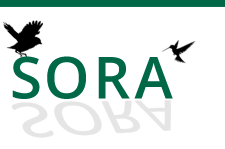Nesting of a Pair of Red-shafted Flickers
Online Full Text
During the winter of 1925 I securely wired into place a dead stub of an alder tree about six feet long and twelve inches through, at a height of fifteen feet in a walnut tree in my back yard here in town. During February and March, 1926, I noticed that a pair of Red-shafted Flickers (Colaptes cafer collaris) was continually working on the stump. Chips from the cavity gradually accumulated on the ground under the tree, and by April 1 the cavity seemed ready for eggs. However, it was not until April 21 that I found the first egg in the nest; on April 26 there were six eggs and the bird was sitting. On the morning of May 7 as I tapped the tree the female left the hole and I examined the nest, to find six small young that had seemingly just hatched, as the egg shells were still in the cavity. On May 11 the youngsters were well developed and hissed loudly when I handled them, but their eyes were not as yet open. The parent birds were apparently not brooding them during the day even though their bodies were bare of feathers. Thev were large enough to band at this time and I placed the following bands on them, nos. 266675, -76, -77, -78, -79, and -80.
On May 15 the eyes of the young flickers were still closed, but they seemed to be just opening on the 16th. At this time the primaries, secondaries and tertiaries were about a quarter of an inch long. The feathers on the dorsal feather tract were just breaking through the skin, and the rectrices were about one-half inch long. Their necks, heads, and under-parts were still bare. The old birds were not about. The young were very noisy, with their grating hissing notes, and seemed strong and healthy, with no parasites in the nest or on them.
I was then away from home for some two weeks in Lower California. When I returned, on June 1, I found the young well able to fly, and they all left the nest on this date.
Thus we note that the adult birds took several weeks at a leisurely pace to build their nesting cavity, even though in a rotten stump; six days to lay their eggs; twelve or thirteen days to hatch them; and that the young stayed in the nest about three weeks. Also that the feather development on the young was very slow at first but speeded up as soon as their bodies were quite large. And also it seems that if we put up suitable nesting sites for this type of bird, it will not be difficult to attract such to our homes. There has been considerable complaint about flickers drilling into the sides of buildings, but if we would give them natural nesting sites it is very probable that they would desist from doing this.
My birds were often seen feeding on the ground in my back yard. Not once did they drum on the house, but used both a tall radio pole next door and their nesting stub for their drumming places. This drumming, which usually took place in the early morning, started in February and was kept up during that month and March. It became less frequent after the eggs were laid, though it was heard at intervals even until the young birds had flown.
Claremont, California, December 10, 1926
Creative Commons License
Recommended Citation
Pierce, Wright M.
(1927)
"Nesting of a Pair of Red-shafted Flickers,"
Condor: Vol. 29
:
Iss.
3
, Article 10.
Available at:
https://digitalcommons.usf.edu/condor/vol29/iss3/10

